|
|
 |
| USDA
Secretary Ann Veneman recently honored several ERS researchers
with the Secretary’s Honor Award. |
|
| Security
Analysis System for U.S. Agriculture |
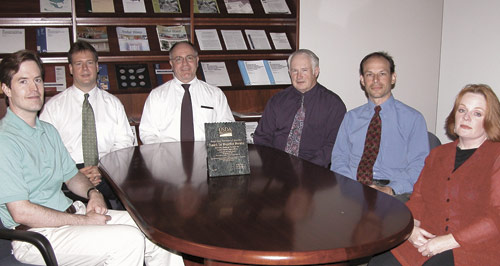
David Nulph, Vincent
Breneman, Greg Pompelli, Fred Hoff, Bryan McEnaney, and
Amy Goldian.
Not shown: Patrick Canning, Paul Chan, Cory Schinkel,
and Zhi Wang. |
In response to increased risks to the Nation’s
agriculture and food supply due to bioterrorism, ERS’s
Security Analysis System for U.S. Agriculture (SAS-USA) team
created a unique system to quantitatively assess agriculture/
food emergencies. The team established a framework to systematically
tie all food supply processes from farm production, food manufacturing,
and distribution of food products to food consumption in every
region of the country. To create this geographic information
system, the team integrated a broad range of data from agencies
within USDA and from many other Federal agencies. These data
collectively describe the interdependencies among different
business sectors spanning all 50 States, the District of Columbia,
and about 500 U.S. ports with an unprecedented level of geographic
detail.
|
| Mitch Morehart |
 |
Mitch Morehart has been a key contributor in the
design and use of USDA’s Agricultural Resource Management
Survey (ARMS) to address the financial status of farms and
the economic position of farm households. ARMS is the only
annual, national-level survey of U.S. farm businesses and
households, providing information about the financial condition
of farms, production practices and resource-use decisions
of farm operators, and the economic status of farm households.
Mitch developed a unique web-based data delivery system to
make ARMS data accessible to a wider audience, greatly simplifying
the process of providing policymakers and other customers
with timely information. His expertise on issues relating
to the financial performance of farm businesses has helped
both USDA and ERS to better position themselves to provide
timely, accurate, and comprehensive information on farm finance
and farm performance to policymakers, researchers, and other
customers.
|
| USDA
Animal Waste Management Team |
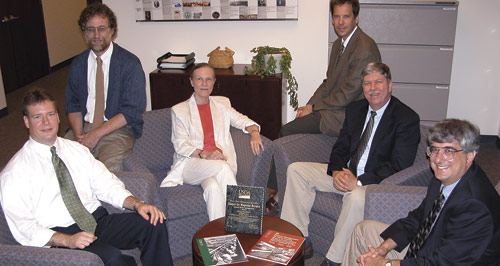
ERS members: Vincent
Breneman, Marcel Aillery, Margriet Caswell, Robert Johansson,
Noel Gollehon (co-leader), and Marc Ribaudo.
Not shown: Jeanmarie Agapoff (now with Farm Service Agency),
Lee Christensen, and Mark Peters (now with Agricultural
Marketing Service). Natural Resources Conservation Service
members, not shown: Daniel Meyer (co-leader), Glenn Carpenter,
Larry Edmonds, Robert Kellogg, Lynn Knight, Barry Kintzer,
Charles Lander, Patty Lawrence, Jerrell Lemunyon, Jeffrey
Loser, and David Moffitt. Cooperative State Research,
Education, and Extension Service members, not shown: Richard
Hegg and Mary Ann Rozum. |
Structural changes in the U.S. livestock sector
over the past 20 years have increased both the size and the
concentration of animal feeding operations. With these increases
came growing public scrutiny and concern for the potential
negative effects of livestock waste on the Nation’s
water resources. The Animal Waste Management Team, consisting
of experts from three USDA agencies, conducted innovative
and timely analysis of the economic and policy options associated
with animal waste management. Co-led by representatives from
ERS and the Natural Resources Conservation Service, the team’s
analysis informed the design of landmark USDA programs and
Environmental Protection Agency regulations to protect water
resources from nutrients contained in animal waste. The team’s
research findings also contributed to the implementation of
the conservation provisions in the Farm Security and Rural
Investment Act of 2002 by informing the structure and expansion
of USDA assistance programs to address the challenge of managing
manure on working lands.
|
| Market
Analysis Program Innovators Team |
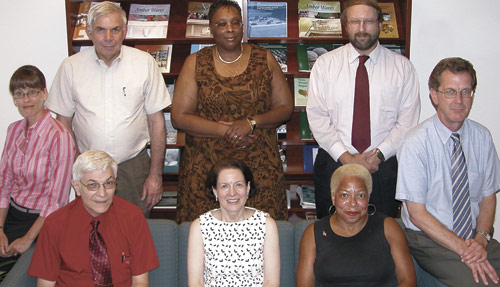
Back row: (l to r)
Mary Maher, Leland Southard, Wynnice Pointer-Napper, Gary
Lucier, and John Dyck.
Front row: (l to r) Allen Baker, Joy Harwood, Fannye Lockley-Jolly.
Not shown: Neil Conklin, Lewrene Glaser, David Johnson,
Andy Kerns, Gerald Bange (World Agricultural Outlook Board),
and Dennis Shields (now with Farm Service Agency).
|
An entirely new market environment with new
and different information needs now confronts decisionmakers,
reflecting changes in the structure of domestic and global
agricultural markets. Simultaneously, information technology
has revolutionized the supply of market information on the
Internet, vastly expanding the potential reach of ERS’s
market analysis program. In cooperation with the World Agricultural
Outlook Board, ERS’s Market Analysis Program Innovators
Team created a program that meets user needs through web-focused
distribution, customer-friendly materials, and targeted coverage
of global food and agriculture product markets. Public- and
private-sector decisionmakers who seek timely, insightful
analysis of the forces shaping agricultural commodity market
behavior now make the ERS outlook
webpage their first stop.
|
| USDA
Food Security Measurement Team |
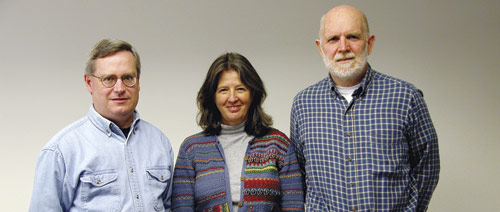
Steven Carlson (Food
Saftey and Nutrition Service), Margaret Andrews, and Mark
Nord. |
In less than a decade, the U.S. household food
security measure has become an important, nationally recognized
research tool for evaluating Federal food assistance programs
and monitoring the adequacy of food access in U.S. households.
Food security—consistent access to enough food for active,
healthy living—is one of several necessary conditions
for a population to be healthy and well nourished. USDA’s
Food Security Measurement Team, with members from ERS and
the Food and Nutrition Service, spearheaded the effort to
develop, assess, and improve the measure. The food security
survey, first conducted as a supplement to the 1995 Current
Population Survey, provided the Nation’s first nationally
representative assessment of household food security and the
extent of food insecurity and hunger. The annual food security
survey has provided data for the Household
Food Security in the United States series of reports
that monitor changing food security conditions. Food security
statistics based on the survey data are used by Federal agencies,
State departments of human services, regional and community
emergency food providers, and advocacy organizations, and
are widely cited by national and local news media.
|
| Margriet
Caswell |
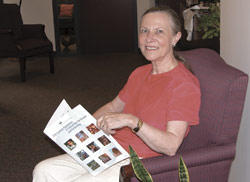 |
Over 90 presenters and panelists from 29 different
countries participated in last year’s International Ministerial
Conference and Expo on Agricultural Science and Technology,
held in Sacramento, California. Cosponsored by the USDA, the
U.S. Agency for International Development, and the U.S. Department
of State, the conference convened many high-level government
officials—including about 60 ministers of agriculture,
18 ministers of science and technology, and about a dozen ministers
of the economy, trade or industry—to discuss how science
and technology can help enhance agricultural productivity, food
security, and economic growth in developing countries. As part
of an interagency team led by USDA’s Foreign Agricultural
Service, Margriet Caswell drafted a USDA report, 21st
Century Agriculture: A Critical Role for Science and Technology,
in which she framed the key issues for discussion at the conference.
|
|

